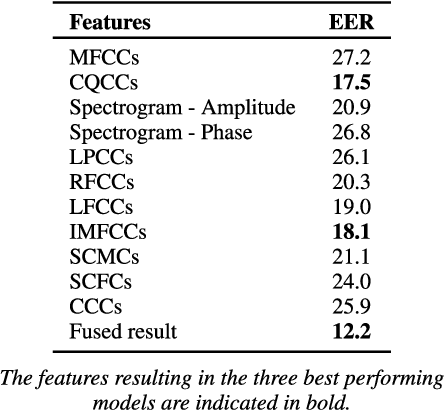Jer-Ming Chen
Cervical Auscultation Machine Learning for Dysphagia Assessment
Jul 08, 2024



Abstract:This study evaluates the use of machine learning, specifically the Random Forest Classifier, to differentiate normal and pathological swallowing sounds. Employing a commercially available wearable stethoscope, we recorded swallows from both healthy adults and patients with dysphagia. The analysis revealed statistically significant differences in acoustic features, such as spectral crest, and zero-crossing rate between normal and pathological swallows, while no discriminating differences were demonstrated between different fluidand diet consistencies. The system demonstrated fair sensitivity (mean plus or minus SD: 74% plus or minus 8%) and specificity (89% plus or minus 6%) for dysphagic swallows. The model attained an overall accuracy of 83% plus or minus 3%, and F1 score of 78% plus or minus 5%. These results demonstrate that machine learning can be a valuable tool in non-invasive dysphagia assessment, although challenges such as sampling rate limitations and variability in sensitivity and specificity in discriminating between normal and pathological sounds are noted. The study underscores the need for further research to optimize these techniques for clinical use.
Performance Assessment of ChatGPT vs Bard in Detecting Alzheimer's Dementia
Jan 30, 2024Abstract:Large language models (LLMs) find increasing applications in many fields. Here, three LLM chatbots (ChatGPT-3.5, ChatGPT-4 and Bard) are assessed - in their current form, as publicly available - for their ability to recognize Alzheimer's Dementia (AD) and Cognitively Normal (CN) individuals using textual input derived from spontaneous speech recordings. Zero-shot learning approach is used at two levels of independent queries, with the second query (chain-of-thought prompting) eliciting more detailed than the first. Each LLM chatbot's performance is evaluated on the prediction generated in terms of accuracy, sensitivity, specificity, precision and F1 score. LLM chatbots generated three-class outcome ("AD", "CN", or "Unsure"). When positively identifying AD, Bard produced highest true-positives (89% recall) and highest F1 score (71%), but tended to misidentify CN as AD, with high confidence (low "Unsure" rates); for positively identifying CN, GPT-4 resulted in the highest true-negatives at 56% and highest F1 score (62%), adopting a diplomatic stance (moderate "Unsure" rates). Overall, three LLM chatbots identify AD vs CN surpassing chance-levels but do not currently satisfy clinical application.
Acoustic prediction of flowrate: varying liquid jet stream onto a free surface
Jun 16, 2020



Abstract:Information on liquid jet stream flow is crucial in many real world applications. In a large number of cases, these flows fall directly onto free surfaces (e.g. pools), creating a splash with accompanying splashing sounds. The sound produced is supplied by energy interactions between the liquid jet stream and the passive free surface. In this investigation, we collect the sound of a water jet of varying flowrate falling into a pool of water, and use this sound to predict the flowrate and flowrate trajectory involved. Two approaches are employed: one uses machine-learning models trained using audio features extracted from the collected sound to predict the flowrate (and subsequently the flowrate trajectory). In contrast, the second method directly uses acoustic parameters related to the spectral energy of the liquid-liquid interaction to estimate the flowrate trajectory. The actual flowrate, however, is determined directly using a gravimetric method: tracking the change in mass of the pooling liquid over time. We show here that the two methods agree well with the actual flowrate and offer comparable performance in accurately predicting the flowrate trajectory, and accordingly offer insights for potential real-life applications using sound.
Towards robust audio spoofing detection: a detailed comparison of traditional and learned features
May 28, 2019



Abstract:Automatic speaker verification, like every other biometric system, is vulnerable to spoofing attacks. Using only a few minutes of recorded voice of a genuine client of a speaker verification system, attackers can develop a variety of spoofing attacks that might trick such systems. Detecting these attacks using the audio cues present in the recordings is an important challenge. Most existing spoofing detection systems depend on knowing the used spoofing technique. With this research, we aim at overcoming this limitation, by examining robust audio features, both traditional and those learned through an autoencoder, that are generalizable over different types of replay spoofing. Furthermore, we provide a detailed account of all the steps necessary in setting up state-of-the-art audio feature detection, pre-, and postprocessing, such that the (non-audio expert) machine learning researcher can implement such systems. Finally, we evaluate the performance of our robust replay speaker detection system with a wide variety and different combinations of both extracted and machine learned audio features on the `out in the wild' ASVspoof 2017 dataset. This dataset contains a variety of new spoofing configurations. Since our focus is on examining which features will ensure robustness, we base our system on a traditional Gaussian Mixture Model-Universal Background Model. We then systematically investigate the relative contribution of each feature set. The fused models, based on both the known audio features and the machine learned features respectively, have a comparable performance with an Equal Error Rate (EER) of 12. The final best performing model, which obtains an EER of 10.8, is a hybrid model that contains both known and machine learned features, thus revealing the importance of incorporating both types of features when developing a robust spoofing prediction model.
 Add to Chrome
Add to Chrome Add to Firefox
Add to Firefox Add to Edge
Add to Edge